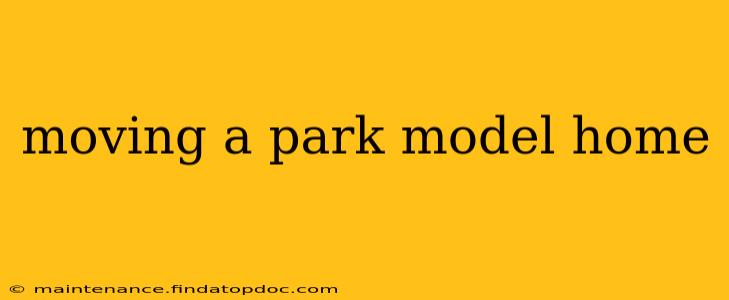Moving a park model home can seem daunting, but with careful planning and the right professionals, it can be a smooth process. This guide covers everything you need to know, from initial preparations to post-move considerations. We'll address common questions and concerns to ensure your move is successful.
What are the Costs Associated with Moving a Park Model Home?
The cost of moving a park model home varies significantly depending on several factors. Distance is a major influencer – longer distances mean higher fuel costs and potentially more permits. The home's size and weight also play a crucial role, as larger and heavier homes require more specialized equipment and expertise. Additional factors include the accessibility of the pickup and delivery locations (narrow roads, difficult terrain can increase costs), and any necessary permits or inspections. You'll need to get multiple quotes from reputable movers specializing in park model relocation to get a clear understanding of the expenses involved. These costs usually cover transportation, any required dismantling or reassembly, and potential damage insurance.
How Do I Find a Reputable Mover for My Park Model Home?
Finding a qualified mover is critical. Don't rely solely on online reviews; conduct thorough research. Look for movers with experience specifically handling park model homes. Check their licensing and insurance coverage; verify that they are adequately insured to cover potential damage during transit. Request references and contact previous clients to inquire about their experiences. Compare multiple quotes, paying close attention to the details of what's included in each offer. Ensure the mover understands the specific requirements of your park model, including its weight and dimensions, and any special considerations like attached decks or awnings.
What Permits and Legal Requirements Do I Need to Move a Park Model Home?
Moving a park model often involves navigating various permits and legal requirements. This typically includes obtaining permits from both your current location and your destination. These permits might involve transportation permits for oversized loads, and possibly building permits at the new location, depending on local regulations. You'll also need to check if there are any specific requirements regarding the home's setup at the new park. It's crucial to thoroughly research and obtain all necessary documentation well in advance of your move to avoid delays. Contacting your local authorities and the park management at both your current and future locations is highly recommended.
Can I Move My Park Model Myself?
Moving a park model home yourself is generally not recommended. These homes are often heavier and more complex than typical trailers, requiring specialized equipment and expertise for safe transportation. Improper handling can lead to significant damage to the home, potential injuries, and legal issues. Hiring a professional mover ensures that the home is handled correctly, minimizing risks and potential problems. The cost savings from attempting a DIY move are likely to be outweighed by the potential for costly repairs or legal complications.
What Preparations Should I Make Before Moving My Park Model Home?
Thorough preparation is key to a smooth move. This involves clearing out the home, removing any fragile or loose items, and securing anything that could shift during transport. Photograph the home's interior and exterior before the move to document its condition. Check with your insurance provider to ensure your policy covers the move, and make sure you have the necessary permits and arrangements in place. Inform the park management of your plans and understand their procedures for moving homes in and out of the park. Planning and careful preparation can significantly reduce stress and potential complications during the move.
How Do I Prepare My Park Model for Transport?
Preparation for transport includes securing all loose items, emptying water tanks, disconnecting utilities, and removing any detachable features that could be damaged during transit. Consider covering the exterior of the home to protect it from scratches and debris during transport. Discuss with your chosen mover any specific instructions or preparation steps they recommend. Their experience and expertise will provide valuable insights to ensure the home arrives at its destination safely and undamaged.
By carefully planning and addressing these points, the process of moving your park model home can be managed effectively. Remember, seeking professional assistance is strongly advised, as it mitigates risks and ensures a safer, smoother relocation.
